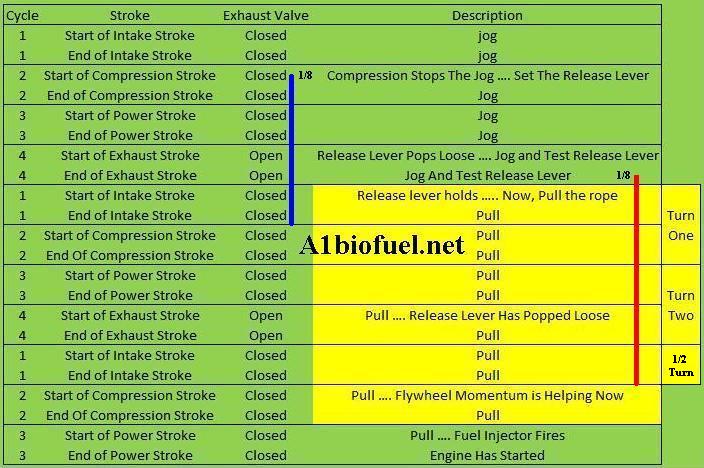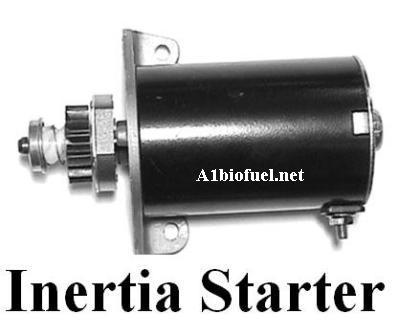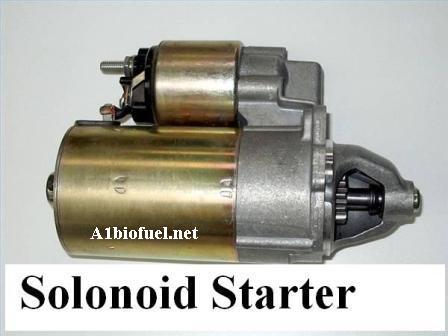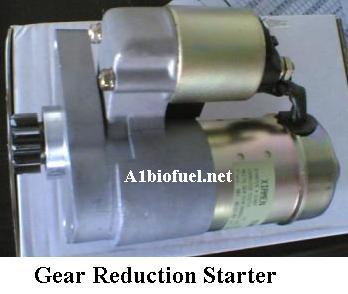Diesel Engine Tips and Information
Overview
Diesels have no spark plugs. They obtain the heat necessary
for combustion by gathering the heat content of the outside air
and putting it
into one small area. The result is an increase of temperature. If 50F degree
air is compressed at a ratio of 20 to 1, it
will yield air at 1,000F degrees (20x50=1000).
Diesel fuel will instantly combust when sprayed into such a hot and oxygen
rich
environment. The rate at which the compression takes place has little
influence on temperature. In other words, it doesn’t matter
how fast
you crank a diesel. What matters is the outside air temperature and the
volatility of the fuel. The most common problems
with a diesel center around
fuel quality and fuel delivery problems. One needs to pay particular attention
to the bleeding of high
pressure and low pressure fuel lines and also the
stoppage of filters. If you get your fuel right, a diesel will almost always
run.
A.
Bleeding Fuel Lines
Because a diesel engine is highly efficient, it injects only
a very small amount of fuel into the cylinder with each stroke. It
can take a
huge amount of engine cranking to work out an air bubble. That is why
bleeding air out of fuel lines is so very important.
First, check the low pressure fuel line
to see if fuel is getting to the injection pump. The best way to do that is to
remove the
fuel hose on the end closest to the pump. Keep a rag handy and reattach
the fuel hose while the fuel is still running out. It does cause
a mess,
but is the most effective way to eliminate air bubbles.
Next, bleed the high pressure fuel line.
That is done by loosening the steel pipe ferrule on the high pressure fuel line
closest to the injector. Set the throttle to maximum, hold down the compression
release lever and crank the engine over until a small drip of fuel comes past
the connection. Retighten the fuel line, reset the throttle to one half
and you are ready to start the engine.
B.
Breaking an engine in
Modern synthetic oils are amazing products. However, you
don’t want to use them in a new engine. Synthetics lubricate so very well
that a new engine will never seat the rings properly. It is
best to start a new engine with frequent oil changes of a non-synthetic oil for
the first 100 hours. After the engine has been broken in, then switch to a good
synthetic. You will find that these small diesel engines will deliver an
amazing amount of service if properly maintained.
C.
Cold Weather Starting
A diesel engine considers anything below 40F degrees to be
cold weather and can be hard to start. That's because there isn't
enough heat content in the outside air to get the temperature of compression
high enough to detonate the diesel fuel. Another problem is that oil companies
change the fuel formula from summer to wintertime blends.
If you get stuck with summer fuel in a
winter situation, then a diesel can be just about impossible to start. Take a
tip from the "old time" truckers. They would mix about 5% gasoline to
their fuel to assist in cold weather starting.
Glow plugs on these small diesels are
available, but end up being a wasted effort. The glow plugs are mounted in the
manifold, not in the cylinder. These diesel engines are not typically used in
wintertime applications, so the manufacturers just don’t provide for
proper glow plugs inside the combustion chamber.
If you really need to run one of these
engines in the winter, then I would go the 5% gasoline fuel mix and find some
way to heat the engine crankcase and especially the incoming air. I have
successfully used a hair dryer to blast warm air down the intake manifold to
raise the temperature of compression.
D.
Recoil Starting
The high compression of diesels can make
them hard to recoil start. Almost
everybody
knows to jog an engine up to the compression stroke, set the
compression
relief and pull start the engine. This old method yields about
2 turns of pull before the next compression stroke. There is a
trick
that will get
you a full 1/2 turn more of momentum on the flywheel.
To do that, set the compression relief
lever. Slowly jog the engine over until it releases. You are now on the exhaust
stroke. Keep slowly jogging the engine and pressing the relief lever until it
will hold down again. You are now at the end of the exhaust stroke. Give the
rope a long, hard pull. The secret is in the long pull. The intention is
to get as much momentum as possible into the flywheel to start the engine.
Another compression stroke actually does come around, but it is skipped because
an exhaust stroke did not precede it. You jogged your way past it. The
compression stroke after the skipped one is the stroke the engine will fire on.
Don't believe me? Try it .... or check out the table listed
below: Keep in mind that the compression relief lever keeps the exhaust valve
slightly open until the cam actuates the exhaust valve and loosens the
compression release lever.
In reality, the situation is a little more extreme than that. In the old method (blue line on the chart) compression stops the crank part way into the compression cycle. That "part way" will give you a little less than 2 turns of remaining pull .... probably 1/8 of a turn (a guess).
With the new method (red line on the chart),
the compression lever will start to hold a little before the exhaust
stroke is complete. Let's guess that also at 1/8 of a turn. But that 1/8
turn is added
to
your potential pull. That gives you a total of 2-3/4 turns
of pull. That additional 3/4 of a turn can make a lot of
difference between a start
and a no-start situation. Examine the chart below.

E. Diesel Smoke.
Diesel
smoke is unburned fuel. The
only way to reduce how much a diesel smokes is to reduce the
unburned
fuel. Either decrease the fuel input or increase the amount of
oxygen to
the engine. Turbo chargers do a good job of oxygen increase. In
non-turbocharged engines, the only choice is to decrease fuel input for
the
present load. That may mean downshifting to reduce load. Or a
person can get an engine that is oversized and simply not work it
as hard. Increasing throttle position beyond the torque an engine can
produce
does not increase power or speed. It just increases smoke.
F.
Compression Relief Compression relief is a very useful thing. Useful in reducing wear and tear on
the starter and also when bleeding fuel lines. It's an absolutely necessity when rope
starting. A compression relief can also stop a diesel "run away" condition.
Unfortunately, due to the popularity of electric starters
and the lack of general diesel knowledge by the public, manufacturers are
beginning to discontinue the compression relief lever. Lower cost is probably also a
reason. I wish they wouldn't do that, but it is probably a reality
we must live with in the future.
G.
What is Diesel Run Away?
Diesel run away only happens with extremely worn out engines and usually only
if they have become very hot. What happens is that on the intake stroke the
piston draws some air from the crankcase that is rich with oil mist, past
the rings into the combustion chamber which acts as a fuel. Because there is no
control over the air intake, the engine will continue to run on its'
own even when the fuel has been shut off. It will keep running until it
has exhausted the crankcase oil and possibly seize the engine.
It's a bad situation and doesn't happen
very often. The only way to stop the engine is either hold down the compression
relief lever, stall the engine or find some way to totally cut off the intake
air.
H.
Electrical Considerations
These engines are designed for off-road stationary power
use and to just recharge the battery from starting. People have used them for all kinds of things .... lawn mowers,
rototillers, stump grinders, electric power, sawmills, garden tractors
and even crazy stuff like sailboats, motorcycles and airplanes. It is
possible to increase the windings in the stator and about double the electrical
output. If you need more than 8 or 10 amps, then check out the forum on
dieselbike.net. A member there called "ThunderCougarFalconBird" has
posted a good series on how he rewound a stator with good success.
I.
Battery Size
Question: How big a battery should I use?
Answer: As big as you physically have
room for.
A battery will wear out in direct proportion as to how hard it
has to work. The typical garden tractor size battery seems to work very well
with these engines. People have used motorcycle batteries, but I would suggest
you get the biggest one you can fit into your battery box.
J. Low Battery Dangers Danger One:
An inertia type starter won't have the proper "quick spin" to fully
engage the pinion gear and grinding of teeth will result. Danger Two: Probably the most serious situation is that a solonoid type starter can keep running and explode the armature!
What happens is the battery voltage has dropped off,
so the starter pulls more amps to compensate. The electrical contacts
can "weld" together and keep the starter running. The only way to stop
the starter is to remove a battery cable. Not an easy thing to do in a
panic situation. Eventually the bushing on the starter drive will
lock and spin up the armature with enough centrifugal force to
make the windings fly apart. A big battery that is discharged seems to
cause this more often than a small battery that is discharged.
K.
Starter Fluid
Oh what a very big No No!
About the only problem we have had with
these engines is with starter fluid. Typically someone runs out of fuel and has
trouble restarting the engine. That's because these is now air in the fuel
lines. So, they attempt to "pop it over" as you would do a gasoline
engine and run it long enough to get fuel worked through the engine.
That is not going to work for two reasons.
Reason One: Diesels are very
efficient and only inject a very small amount of fuel on each stroke. It can
take a very long time to crank out an air bubble. Opening the throttle all the
way and holding down the compression relief will help, but still it's a whole
lot of cranking and you will probably run down the battery several times before
the bubble is worked out.
Reason Two: Because of the high
temperature of compression the starter spray will ignite before top
dead center and cause engine to kick backwards. If the engine kicks back fast, it
will usually break the starter drive gear or the starter nose cone. If it kicks
back slow enough, it can get the armature spinning in reverse and cause
enough centrifugal force to cause the armature to explode.
If you run out of fuel you need to bleed
the fuel lines. A word to
the wise is never run a diesel dry and never, never introduce any type
of fuel into the intake manifold.
L.
Starter Types
The most common complaint we have is about starters.
Normally it is a result of fuel issues, bad batteries or starter
spray that has caused over work or damage to the starter. If
a person is aware of the various types of starters and their various
strengths and weaknesses, then possibly damage to the starters can be
reduced.
1. Inertia Drive Starters
Inertia drive starters are the most
common type found on small engines. They are small and inexpensive to
manufacture.
They work just fine, however they do suffer from a few problems. If they lose
lubrication on the worm drive they will have problems with kicking in. Also,
they need a fully charged battery to insure a quick snap of the armature
to kick in the drive gear without grinding teeth.
 2. Solenoid Starters
The public is more familiar with
solenoid
starters as they are the same type found on automobiles.
They
will kick in fine with a low battery but will just crank slowly. That's
a good thing because the average person will understand that their
battery is weak.
2. Solenoid Starters
The public is more familiar with
solenoid
starters as they are the same type found on automobiles.
They
will kick in fine with a low battery but will just crank slowly. That's
a good thing because the average person will understand that their
battery is weak.
 3. Gear Reduction Starters
Gear reduction starters are the
best.
They are more expensive to manufacture, but are smaller and
generate a large amount of starting torque. They are more
efficient, so
they are more tolerant of an undersized or weak battery. Normally
they are considered to be optional equipment. The one cylinder engines
do fine on a direct drive starter. Most of the v-twin engines do have direct drive starters, but we are encouraging the
manufacturers to make gear reduction starters standard for all the v-twin engines.
3. Gear Reduction Starters
Gear reduction starters are the
best.
They are more expensive to manufacture, but are smaller and
generate a large amount of starting torque. They are more
efficient, so
they are more tolerant of an undersized or weak battery. Normally
they are considered to be optional equipment. The one cylinder engines
do fine on a direct drive starter. Most of the v-twin engines do have direct drive starters, but we are encouraging the
manufacturers to make gear reduction starters standard for all the v-twin engines.
 M.
Vibration Issues
1. The one cylinder diesels seem to run pretty
smooth. They have
an internal counter balance shaft that runs at the same speed as the
crank
shaft but in the opposite direction. It will cancel
most of the vibration from piston movement. Experts have argued
that you cannot
cancel a linear vibration with a rotational vibration. In the
strictest
theoretical sense that is true. However you can reduce the overall net
vibrational
effect with the proper use of a counterbalance shaft. The Winsun 13hp
engine
runs particularly smooth for being a light weight diesel engine.
2. The v-twins are another matter. There
is no practical way to mount a counter balance shaft that will cancel the
complex vibrations of a 90 degree v-twin engine. All v-twin engines
vibrate to some degree. Usually they will have one or two "sweet spots". The problem is not
all that bad .... Harley Davidson motorcycles have always suffered from vibrational
problems and there are thousands of them running down the highways every day. Ken
Mosi built a Punsun v-twin scooter that has a directly bolted down engine.
He rides the scooter every day to work and has no problem.
3. The only vibration issue we have experienced is
sometimes on a v-twin, the thin steel high pressure fuel line will
crack from vibration. I understand from diesel truck mechanics that
this is a common problem. It is due to the individual harmonic
vibration frequency of a particular fuel line. Repair is by replacement
of the fuel line and possibly adding some support or a loop to change
the natural resonant frequency of that line. Fortunately, it is a fairly simple
and inexpensive repair. The lines are standard metric sizes that almost
any hydraulic supply house can fabricate one if you give them the old line
as a sample.
N.
Flywheel Stub Shafts and Custom Power Shafts
From time to time we get requests for engines with stub
shafts on the flywheel or custom size power shafts. People are trying to
replace the engine in their unusual make or model garden tractor or lawn
mower. In the past, we have made attempts to have the factories in China
manufacture these items. The willingness and friendliness of the Chinese
manufacturers has been good. Unfortunately, the results of these custom jobs
has not turned out to be as good as one would hope. Both the V-twins and 1 cylinder engines come
with 1 inch diameter power shafts only.
Although we have sold many successful lawn
mower and garden
tractor replacements, we want to leave the custom work in the hands of
the
consumer. We are a low cost diesel engine supplier and have no
facilities to do custom machine work. Please do not ask us to
arrange or do
custom machine work. All the custom stuff is up to you.
M.
Vibration Issues
1. The one cylinder diesels seem to run pretty
smooth. They have
an internal counter balance shaft that runs at the same speed as the
crank
shaft but in the opposite direction. It will cancel
most of the vibration from piston movement. Experts have argued
that you cannot
cancel a linear vibration with a rotational vibration. In the
strictest
theoretical sense that is true. However you can reduce the overall net
vibrational
effect with the proper use of a counterbalance shaft. The Winsun 13hp
engine
runs particularly smooth for being a light weight diesel engine.
2. The v-twins are another matter. There
is no practical way to mount a counter balance shaft that will cancel the
complex vibrations of a 90 degree v-twin engine. All v-twin engines
vibrate to some degree. Usually they will have one or two "sweet spots". The problem is not
all that bad .... Harley Davidson motorcycles have always suffered from vibrational
problems and there are thousands of them running down the highways every day. Ken
Mosi built a Punsun v-twin scooter that has a directly bolted down engine.
He rides the scooter every day to work and has no problem.
3. The only vibration issue we have experienced is
sometimes on a v-twin, the thin steel high pressure fuel line will
crack from vibration. I understand from diesel truck mechanics that
this is a common problem. It is due to the individual harmonic
vibration frequency of a particular fuel line. Repair is by replacement
of the fuel line and possibly adding some support or a loop to change
the natural resonant frequency of that line. Fortunately, it is a fairly simple
and inexpensive repair. The lines are standard metric sizes that almost
any hydraulic supply house can fabricate one if you give them the old line
as a sample.
N.
Flywheel Stub Shafts and Custom Power Shafts
From time to time we get requests for engines with stub
shafts on the flywheel or custom size power shafts. People are trying to
replace the engine in their unusual make or model garden tractor or lawn
mower. In the past, we have made attempts to have the factories in China
manufacture these items. The willingness and friendliness of the Chinese
manufacturers has been good. Unfortunately, the results of these custom jobs
has not turned out to be as good as one would hope. Both the V-twins and 1 cylinder engines come
with 1 inch diameter power shafts only.
Although we have sold many successful lawn
mower and garden
tractor replacements, we want to leave the custom work in the hands of
the
consumer. We are a low cost diesel engine supplier and have no
facilities to do custom machine work. Please do not ask us to
arrange or do
custom machine work. All the custom stuff is up to you.
(Bottom
of Page)